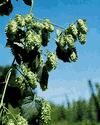- hop
-
hop1
—hoppingly, adv.v.i.1. to make a short, bouncing leap; move by leaping with all feet off the ground.2. to spring or leap on one foot.3. Informal. to make a short, quick trip, esp. in an airplane: He hopped up to Boston for the day.4. Informal. to travel or move frequently from one place or situation to another (usually used in combination): to island-hop; to job-hop.5. Informal. to dance.v.t.6. to jump over; clear with a hop: The sheep hopped the fence.7. Informal. to board or get onto a vehicle: to hop a plane.8. Informal. to cross in an airplane: We hopped the Atlantic in five hours.9. hop to it, Informal. to begin to move, become active, or do something immediately: You'd better hop to it if you intend to buy groceries before the market closes. Also, hop to.n.10. an act of hopping; short leap.11. a leap on one foot.12. a journey, esp. a short trip by air.13. Informal. a dance or dancing party.14. a bounce or rebound of a moving object, as a ball: She caught the ball on the first hop.[bef. 1000; ME hoppen (v.), OE hoppian; c. G hopfen, ON hoppa]hop2n.1. any twining plant of the genus Humulus, bearing male flowers in loose clusters and female flowers in conelike forms.2. hops, the dried ripe cones of the female flowers of this plant, used in brewing, medicine, etc.3. Older Slang. a narcotic drug, esp. opium.v.t.4. to treat or flavor with hops.a. to excite; make enthusiastic: They hopped the crowd up with fiery speeches.b. to add to the power of: The kids hopped up the motor of their jalopy.c. to stimulate by narcotics.
* * *
In botany, either of two species of the genus Humulus, nonwoody annual or perennial vines in the hemp family, native to temperate North America, Eurasia, and South America.The hops used in the brewery industry (see beer) are the dried female flower clusters (cones) of the common hop (H. lupulus), a long-lived perennial with rough twining stems. Hops impart a mellow bitterness and delicate aroma to brewed beverages and aid in their preservation. The Japanese hop (H. japonicus) is a quick-growing annual species used as a screening vine. Hop vine (Humulus lupulus) with female flowers (cones) used in brewing.Grant Heilman
Hop vine (Humulus lupulus) with female flowers (cones) used in brewing.Grant Heilman* * *
▪ planteither of two species of the genus Humulus, nonwoody annual or perennial vines in the hemp family (Cannabinaceae) native to temperate North America, Eurasia, and South America. The hops used in the brewing industry are the dried female flower clusters (cones) of the common hop (H. lupulus). The Japanese hop (H. japonicus) is a quick-growing annual species used as a screening vine.Hops have been used almost exclusively for brewing purposes for 1,200 years or more. The brewing value of the cones is based on their content of bitter (soft) resins, essential oils, and perhaps tannins. These constituents, which are extracted from hops by boiling in wort (an aqueous infusion of malt), impart the desired mellow bitterness and delicate hop aroma to brewed beverages and aid in their preservation.The common hop is a long-lived herbaceous perennial with rough twining stems, 8 metres (26 feet) long, that always wind in a clockwise direction. New vines (also called bines) are produced each season and die following maturity. The vines must be supported on sturdy trellises. An extensive root system penetrates the soil to a depth of 5 metres (16 feet) or more.Hops are grown commercially over a wide range of climatic and soil conditions. In general, rich alluvial soils or deep sandy or gravelly, well-drained loams are preferred. Hops are commonly produced under irrigation in the United States where summertime precipitation is low. Irrigation is not practiced in England, where rainfall during the growing season is usually sufficient to raise the plants. Hop cones are harvested when fully mature, picked either by hand or by machine. Freshly picked hops have a high moisture content and must be dried in kilns before they can be used in brewing. After drying, they are cured and baled and are then ready for marketing. Major world producers include Germany, the United States, the Czech Republic, China, and England.* * *
Universalium. 2010.
